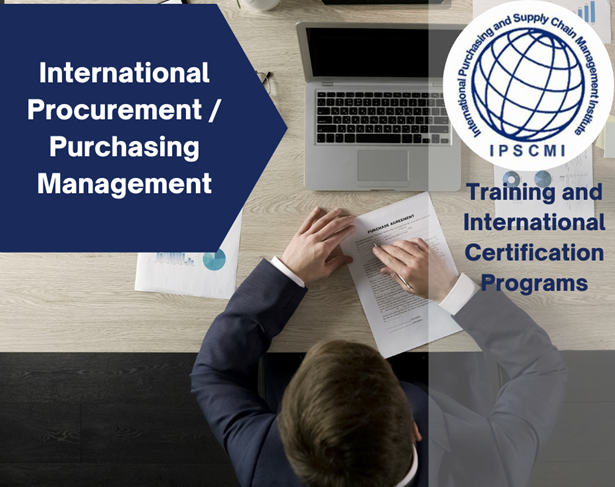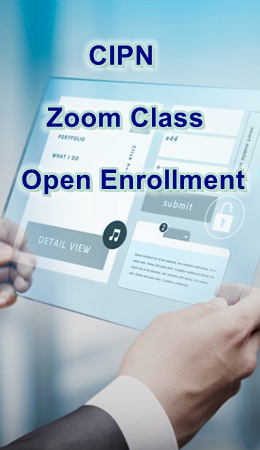Home > Certifications > Purchasing Management Series > Certified International Purchasing/Procurement Professional (CIPP, Level 1) >
Certified International Purchasing/Procurement Professional (CIPP, Level 1)

Certified International Purchasing/Procurement Professional (CIPP, Level 1)
The Certified International Purchasing/Procurement Professional (CIPP) is the first level of three IPSCMI International Purchasing Management certifications. CIPP is designed for current and future purchasing professionals, reflecting levels of understanding and of competence needed to assume responsibility for managing purchasing operations at the international level.
Certification Objectives
1. To promote recognition and acceptance of professional status for certified people involved in procurement and supply chain management.
2. To develop performance standards and operational guidelines which can improve the efficiency and effectiveness of purchasing.
3. To develop and live by a code of ethical standards for purchasing operations under which modern business practices might be more clearly understood and favorably accepted by the public in general.
4. To increase the degree to which the individual gains personal confidence, satisfaction, and pride from direct involvement in purchasing operations.
Certification BOK
Module 1 Specifying Requirements and Advance Procurement Planning
1. Explain the principles of purchasing (applicable to both private and public sector organizations and to both for profit and non-profit organizations.)
2. Explain the Pareto Principle and how it applies in purchasing.
3. Demonstrate the computation of percentages and calculate simple formulas found in the purchasing process.
4. Given mathematical problems typically encountered in purchasing, calculate fractions, decimals, and ratios.
5. Calculate interest rates, payback period, net present value, and other calculations considering the time value of money.
6. Employ the several methods of forecasting used in the purchasing process.
7. Compute various types of averages (mode, mean, and median).
8. Explain standard deviation and how to calculate and use it in purchasing.
9. Describe the forms typically used in purchasing and explain how those forms can be modified for use in E-Procurement.
10. Describe the various hardware and software options available for automation of the purchasing process.
11. Develop/utilize a computerized purchasing system (e.g., online buying, EDI, Web-based electronic commerce) with an ultimate goal of “paperless purchasing”.
12. Develop/implement/maintain a database of specifications, suppliers, products, and/or services.
13. Develop/utilize a computerized inventory and/or capital equipment tracking system.
14. Explain the advantages and disadvantages of single and multi-sourcing.
15. Explain the advantages and disadvantages of centralized and decentralized purchasing.
16. Establish procurement plans and make decisions necessary to purchase products or services in congruence with organizational objectives and sourcing strategies.
17. Explain how the purchasing manager uses the concepts of supply and demand in evaluating markets and potential suppliers.
18. List and describe the various types of markets, including free markets, oligopolies, monopolies, monopsonies, and oligopsonies and how they affect the ability of the purchaser to obtain competition and fair and reasonable prices.
19. Describe the different methods of acquisition (direct, off-shore buying office, etc.) for global sourcing.
20. Explain how to develop global procurement plans stemming from organizational goals.
21. Explain how different business customs and courtesies of key nationalities affect the offshore purchasing process.
22. Describe several global trade barriers and how they affect the global sourcing process.
23. Read blueprints and engineering drawings and explain the various symbols and notations on those drawings.
24. Explain how engineering supports the purchasing process and the methods of cooperation between purchasing and engineering.
25. Review purchase requisitions in accordance with organizational requirements and/or budgetary constraints.
26. Determine appropriate methods of procurement, including the different methods of E-Procurement.
27. Perform cost/benefit analyses on planned purchases.
28. Develop/review specifications, statements of work, performance terms, and/or acceptance criteria.
Module 2 Appraising and Shortlisting Suppliers
29. Locate (through internet market surveys and other means) potential sources of materials or services.
30. Explain the process of qualifying/prequalifying and selecting domestic and offshore suppliers.
31. Manage and develop automated lists of recommended sources.
32. Explain how to use supplier catalogs, including online catalogs.
33. Review supplier samples and/or demonstrations with the buying organization management and/or user departments.
Module 3 Obtaining and Evaluating Offers
34. Prepare bid and proposal solicitations with pertinent specifications, terms, and conditions including digitalized solicitations for posting to an internet, extranet, or intranet “bid room” and solicitations appropriate for “online auctioning” and “reverse auctioning”.
35. Explain the use of third parties in the solicitation and bidding process.
36. Describe the various E-Procurement tools available to the buyer, including internet, intranet, extranet, application service provider (ASP), server-based, ERP, stand-alone, exchanges, and B2B hubs.
37. Describe how Electronic Data Interchange (EDI) and Value Added Networks (VANS) can be used to facilitate the purchasing process.
38. Use price, cost, and financial analytical techniques to evaluate offers and proposals to determine the overall best offer for a product/service.
39. Explain the various economic theories relating to supplier pricing of good and services.
40. Explain the concept of price elasticity of demand.
41. Explain how the purchasing manager uses supplier financial accounting information, including balance sheets, income statements, and cash flow statements to make decisions concerning supplier financial capability and qualifications.
42. Using supplier financial statements, calculate the current ratio, acid test/quick ratio, and debt to equity ratio and explain how those computed ratios will influence your decision concerning that supplier.
43. Explain how the purchasing manager uses internal and/or supplier management or cost accounting information to make decisions, including cost/volume/profit and breakeven analysis, make or buy analysis, learning curve analysis, and development of cost estimating relationships.
44. Describe the process of developing the total landed cost of acquisition.
Module 4 Negotiating
45. Explain the principles of negotiation according to Lewicki, Karras, and Fisher/Ury.
46. Explain when purchasing people should negotiate and when they probably should not negotiate.
47. Explain how to plan, organize, and conduct a negotiation conference.
48. Prepare for and develop strategies and tactics for negotiations.
49. Conduct negotiations with domestic and international suppliers and explain how global negotiations differ from domestic negotiations.
50. Conduct supplier visits/evaluations and conduct “due diligence” to determine qualification and responsibility of potential suppliers either on a “prequalification” basis or immediately prior to award.
Module 5 Preparing the Contract
51. Describe provisions/clauses appropriate for inclusion in the international contract for purchase.
52. Based on economic, political, and trade-related factors, determine whether to denominate a contract in dollars or in the (foreign) currency of the offshore supplier.
53. Explain how and when to employ legal counsel in support of the purchasing process.
54. Explain the different laws governing contracts from offshore suppliers (CISG and UCC) and how they impact on risk of buyer contract performance.
55. Explain the different International Commercial Terms (INCOTERMS).
56. Explain the documentation required in international trade. (Bill of Lading and Other International Purchasing Documents).
57. Explain how the Uniform Commercial Code (UCC), particularly Article 2, Sales affects the purchasing process.
58. Explain when a contract needs to be in writing and why.
59. Describe the basic elements of the anti-trust laws (including Sherman Anti-Trust) and how they affect the buyer as well as the seller.
60. Explain reciprocity and the legal implications of reciprocity.
61. Explain the different types of warranties, including the UC warranties of “merchantability” and “fitness for its intended purpose”.
62. Describe the legal recourses available to the buyer if the seller fails to perform as agreed in the contract.
63. Obtain legal review and approval of a contract or purchase order when required.
64. Prepare and/or issue contracts/purchase orders, including hardcopy and/or electronic.
Module 6 Managing the Contract and Supplier Relationships
1. Explain the principles of purchasing (applicable to both private and public sector organizations and to both for profit and non-profit organizations.)
2. Explain the Pareto Principle and how it applies in purchasing.
3. Demonstrate the computation of percentages and calculate simple formulas found in the purchasing process.
4. Given mathematical problems typically encountered in purchasing, calculate fractions, decimals, and ratios.
5. Calculate interest rates, payback period, net present value, and other calculations considering the time value of money.
6. Employ the several methods of forecasting used in the purchasing process.
7. Compute various types of averages (mode, mean, and median).
8. Explain standard deviation and how to calculate and use it in purchasing.
9. Describe the forms typically used in purchasing and explain how those forms can be modified for use in E-Procurement.
10. Describe the various hardware and software options available for automation of the purchasing process.
11. Develop/utilize a computerized purchasing system (e.g., online buying, EDI, Web-based electronic commerce) with an ultimate goal of “paperless purchasing”.
12. Develop/implement/maintain a database of specifications, suppliers, products, and/or services.
13. Develop/utilize a computerized inventory and/or capital equipment tracking system.
14. Explain the advantages and disadvantages of single and multi-sourcing.
15. Explain the advantages and disadvantages of centralized and decentralized purchasing.
16. Establish procurement plans and make decisions necessary to purchase products or services in congruence with organizational objectives and sourcing strategies.
17. Explain how the purchasing manager uses the concepts of supply and demand in evaluating markets and potential suppliers.
18. List and describe the various types of markets, including free markets, oligopolies, monopolies, monopsonies, and oligopsonies and how they affect the ability of the purchaser to obtain competition and fair and reasonable prices.
19. Describe the different methods of acquisition (direct, off-shore buying office, etc.) for global sourcing.
20. Explain how to develop global procurement plans stemming from organizational goals.
21. Explain how different business customs and courtesies of key nationalities affect the offshore purchasing process.
22. Describe several global trade barriers and how they affect the global sourcing process.
23. Read blueprints and engineering drawings and explain the various symbols and notations on those drawings.
24. Explain how engineering supports the purchasing process and the methods of cooperation between purchasing and engineering.
25. Review purchase requisitions in accordance with organizational requirements and/or budgetary constraints.
26. Determine appropriate methods of procurement, including the different methods of E-Procurement.
27. Perform cost/benefit analyses on planned purchases.
28. Develop/review specifications, statements of work, performance terms, and/or acceptance criteria.
Module 2 Appraising and Shortlisting Suppliers
29. Locate (through internet market surveys and other means) potential sources of materials or services.
30. Explain the process of qualifying/prequalifying and selecting domestic and offshore suppliers.
31. Manage and develop automated lists of recommended sources.
32. Explain how to use supplier catalogs, including online catalogs.
33. Review supplier samples and/or demonstrations with the buying organization management and/or user departments.
Module 3 Obtaining and Evaluating Offers
34. Prepare bid and proposal solicitations with pertinent specifications, terms, and conditions including digitalized solicitations for posting to an internet, extranet, or intranet “bid room” and solicitations appropriate for “online auctioning” and “reverse auctioning”.
35. Explain the use of third parties in the solicitation and bidding process.
36. Describe the various E-Procurement tools available to the buyer, including internet, intranet, extranet, application service provider (ASP), server-based, ERP, stand-alone, exchanges, and B2B hubs.
37. Describe how Electronic Data Interchange (EDI) and Value Added Networks (VANS) can be used to facilitate the purchasing process.
38. Use price, cost, and financial analytical techniques to evaluate offers and proposals to determine the overall best offer for a product/service.
39. Explain the various economic theories relating to supplier pricing of good and services.
40. Explain the concept of price elasticity of demand.
41. Explain how the purchasing manager uses supplier financial accounting information, including balance sheets, income statements, and cash flow statements to make decisions concerning supplier financial capability and qualifications.
42. Using supplier financial statements, calculate the current ratio, acid test/quick ratio, and debt to equity ratio and explain how those computed ratios will influence your decision concerning that supplier.
43. Explain how the purchasing manager uses internal and/or supplier management or cost accounting information to make decisions, including cost/volume/profit and breakeven analysis, make or buy analysis, learning curve analysis, and development of cost estimating relationships.
44. Describe the process of developing the total landed cost of acquisition.
Module 4 Negotiating
45. Explain the principles of negotiation according to Lewicki, Karras, and Fisher/Ury.
46. Explain when purchasing people should negotiate and when they probably should not negotiate.
47. Explain how to plan, organize, and conduct a negotiation conference.
48. Prepare for and develop strategies and tactics for negotiations.
49. Conduct negotiations with domestic and international suppliers and explain how global negotiations differ from domestic negotiations.
50. Conduct supplier visits/evaluations and conduct “due diligence” to determine qualification and responsibility of potential suppliers either on a “prequalification” basis or immediately prior to award.
Module 5 Preparing the Contract
51. Describe provisions/clauses appropriate for inclusion in the international contract for purchase.
52. Based on economic, political, and trade-related factors, determine whether to denominate a contract in dollars or in the (foreign) currency of the offshore supplier.
53. Explain how and when to employ legal counsel in support of the purchasing process.
54. Explain the different laws governing contracts from offshore suppliers (CISG and UCC) and how they impact on risk of buyer contract performance.
55. Explain the different International Commercial Terms (INCOTERMS).
56. Explain the documentation required in international trade. (Bill of Lading and Other International Purchasing Documents).
57. Explain how the Uniform Commercial Code (UCC), particularly Article 2, Sales affects the purchasing process.
58. Explain when a contract needs to be in writing and why.
59. Describe the basic elements of the anti-trust laws (including Sherman Anti-Trust) and how they affect the buyer as well as the seller.
60. Explain reciprocity and the legal implications of reciprocity.
61. Explain the different types of warranties, including the UC warranties of “merchantability” and “fitness for its intended purpose”.
62. Describe the legal recourses available to the buyer if the seller fails to perform as agreed in the contract.
63. Obtain legal review and approval of a contract or purchase order when required.
64. Prepare and/or issue contracts/purchase orders, including hardcopy and/or electronic.
Module 6 Managing the Contract and Supplier Relationships
65. Administer contracts/purchase orders from award to completion, including use of automated contract management systems.
66. Explain the complexities of administering a contract awarded to an offshore supplier.
67. Maintain effective and efficient relationships with other internal departments involved in procurement and contract administration.
68. Explain the various theories of motivation in order to understand what motivates people and describe the method(s) which work best for you.
69. Explain the impact of motivation on productivity and job satisfaction.
70. Participate in cross-functional and/or multifunctional teams (e.g., project management, process improvement).
71. Develop/manage effective relationships with suppliers, utilizing such techniques as supplier partnerships, strategic alliances, supply chain management, and supplier training programs.
72. Explain the various customs laws, regulations, and tariffs and how they affect the supply management process.
73. Review product availability and/or pricing information with suppliers.
74. Conduct interviews with current and prospective supplier sales personnel.
75. Coordinate/review/respond to supplier inquiries, protests, and appeals.
76. Expedite deliveries and conduct follow-up procedures when necessary.
77. Resolve contract/purchase order differences with suppliers.
78. Describe when quality begins and what the buyer should do to obtain a quality product.
79. Define quality from a purchasing point of view (the product meets the agreed specification).
80. Resolve quality problems with suppliers and user departments.
81. Develop measurements of quality improvement and target setting (e.g., “best in class” benchmarks).
82. Support and assist accounts payable in providing effective and efficient payments to suppliers.
83. Describe the different methods of electronic payments and explain the advantages and disadvantages of those various methods. Explain the several different methods of payment available for offshore purchases and which of those are most advantageous to the buyer.
84. Resolve payment problems with suppliers and user departments.
85. Manage automated and hardcopy files of contracts, purchase orders, agreements, equipment records, and/or specifications.
86. Measure supplier performance using rating systems and/or predetermined standards.
Examinations
Completion of the certification program requires completion of an 80 question multiple choice examination prepared from the INTERNATIONAL PURCHASING MANAGEMENT BODY OF KNOWLEDGE (IPMBOK). The examination is prepared by a Board of Examiners consisting of a range of Certified, Sustaining, and Educator Members within the three above Institutes/Societies.
The examination locations are determined by the individual candidates and their proctors. A proctor may be an individual who is currently an active Certified Member, or a manager, supervisor, teacher, professor, or anyone of such standing. Each proctor is determined on a case-by-case basis. IPSCMI wishes to make it possible for every qualified candidate to complete the certification program in a convenient and timely manner.
Minimum Requirements
Candidates who wish to become certified must meet the following requirements:
1. AA degree OR more than three years of experience in purchasing/supply chain management.
2. Satisfactory completion of a 3 hour multiple choice examination covering the INTERNATIONAL PURCHASING MANAGEMENT BODY OF KNOWLEDGE (IPMBOK) addressed in the training program.
3. Completion of an application for certification and payment of all fees.








